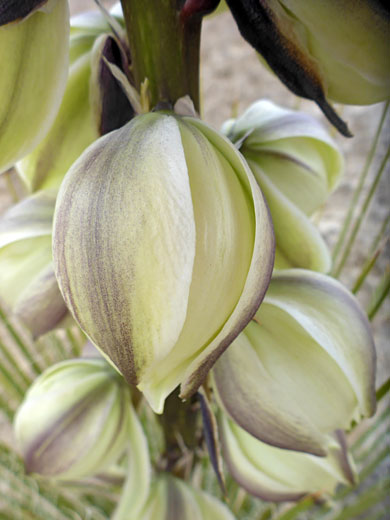Scientific name:
Yucca baileyi
Common name:
Navajo yucca, Alpine yucca
Range:
Four Corners area (AZ, CO, NM, UT) extending east across parts of the Colorado Rockies. Also a separate population in the mountains of west New Mexico
Form:
Stemless, solitary or forming clusters, up to 6 feet in diameter
Habitat:
Grassland, woodland, hillsides, from 4,200 to 8,000 feet
Flowers:
Bell-shaped, pendent, white with purplish bracts; on a stalk up to 2 feet tall
Yucca baileyi is a common species of the Navajo Reservation, in Utah, Arizona and New Mexico, hence its common name of Navajo yucca, though the range extends northeastwards into the Colorado Rockies, up to 8,000 feet elevation.
Leaves are rigid, yellowish-green in color, narrow (less than half an inch across), and up to 18 inches long. Leaf margins are slightly recurved, and are lined with curling, white fibers. Leaves terminate in a spine, around one inch in length.
The flowers are held on a stalk of up to 2 feet, partly within the leaves; for some similar species they are well above the leaves. The bell-shaped flowers hang downwards when mature, and are subtended by purplish bracts. Petals are white to pale creamy yellow. The style is white, the stigma green. The inflorescence is a raceme; an unbranched, elongated cluster. Fruits are dehiscent, splitting to release the seeds.
Leaves are rigid, yellowish-green in color, narrow (less than half an inch across), and up to 18 inches long. Leaf margins are slightly recurved, and are lined with curling, white fibers. Leaves terminate in a spine, around one inch in length.
The flowers are held on a stalk of up to 2 feet, partly within the leaves; for some similar species they are well above the leaves. The bell-shaped flowers hang downwards when mature, and are subtended by purplish bracts. Petals are white to pale creamy yellow. The style is white, the stigma green. The inflorescence is a raceme; an unbranched, elongated cluster. Fruits are dehiscent, splitting to release the seeds.
All Contents © Copyright The American Southwest | Comments and Questions | Contribute | Affiliate Marketing Disclosure | Site Map




